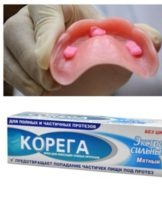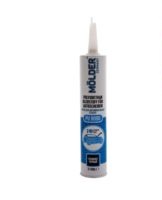Description and use of polyurethane glue UR-600, instructions for use
Adhesives are popular in daily life, widely used in the automotive industry, furniture and shoe production. Glue "UR-600" has advantages over other brands in terms of quality and adhesive strength, resistance to aggressive environments, temperature extremes and the absence of toxic additives. Convenient packaging and long shelf life complete the list of positive properties of glue.
Description and function of the adhesive
Glue "UR-600" is a solution of polyurethane rubbers in ethyl acetate and acetone in a 1: 1 ratio without other additives. The adhesive is transparent and leaves no traces when dry. "UR-600" is used in the manufacture of:
- furniture;
- cars;
- plastic windows;
- in the production, repair of footwear and leather goods;
- for household needs.
The glue firmly connects the products:
- PVC;
- rubber;
- leather (natural and artificial);
- Plastic;
- polyurethane;
- plexiglass;
- paper;
- cardboard;
- fabrics;
- fiberboard;
- chipboard;
- thermoplastic elastomer;
- metal.
The 750 milliliter to 20 liter packs are convenient for use at work and at home.
Brand Features
Glue "UR-600" refers to multifunctional compositions, as it has good adhesive properties to most materials.The adhesive comes into contact with the surfaces to form a strong, elastic and colorless joint. The connection resists dynamic stresses (vibrations), atmospheric exposure: ultraviolet and high humidity.
The adhesive does not react:
- with water;
- alkalis;
- weak acids;
- gasoline;
- oils.
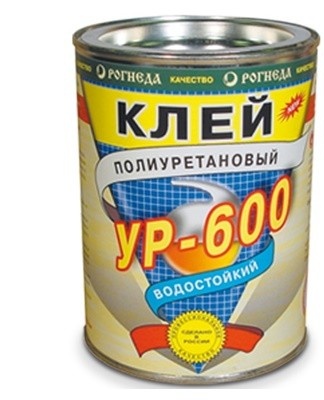
The adhesive properties of the glue do not change with temperature drops from -50 to +120 degrees. Due to the listed characteristics, "UR-600" can be used for both external and internal work.
"UR-600" does not require the use of additional components in the form of a hardener, does not contain toxic toluene. The purchased glue is ready for use.
The density of the composition varies from 0.87 to +/- 0.20 grams per cubic centimeter. The relative viscosity (fluidity) of VZ-246 corresponds to 120 seconds. It refers to the time during which part of the adhesive composition lends itself to uniform distribution on the surface of the material. The thickened glue is diluted to the desired consistency with acetone.
The seam strength specified by the manufacturer is obtained after twice applying the compound to the mating surfaces. The time interval between the application of layers is 10 to 30 minutes, depending on the method of application. The complete cure time also depends on the method of application: cold or hot. In the first case, this period lasts 24 hours, in the second - 4 hours.
The glue is stored and transported in a tightly closed container at a temperature of 5 to 40 degrees Celsius. At lower temperatures, the adhesive loses its viscosity. To restore it, the composition is placed in a warm room or warm water heated to + 10 ... + 40 degrees, stirring constantly.The shelf life of "UR-600" is 5 years.
Rules and instructions for use
Material surfaces must be prepared before bonding:
- eliminate contamination;
- sanding (porous);
- degrease;
- dry.
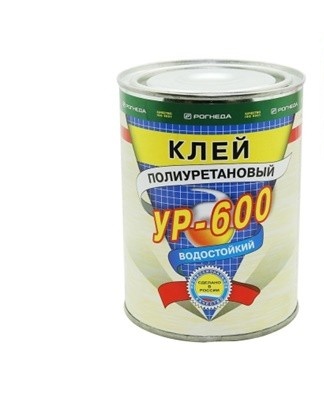
Acetone is used for degreasing.Paper, fabric bases are cleaned of dust. The plexiglass is washed with dishwashing detergent and rinsed with clean water. Rust and scale are removed from metal products using tools and grinding devices. The surfaces are dusted, washed with acetone. Surfaces made of polyurethane, PVC, wood chips, wood fibers are wiped with a degreaser. Leather (natural, artificial), rubber is sanded without further treatment with acetone.
Two bonding methods are used:
- Cold. A layer of glue 1 to 2 mm thick is applied to the prepared surfaces and kept for 10 to 15 minutes, depending on room or outdoor temperature. Then a second layer is applied and dried for 3-5 minutes. The surfaces are pressed together with effort for 1-2 minutes. Final hardening will end within a day, after which the product can be used.
- Hot. The glue is applied in an even, thin layer and dried for 15-30 minutes. Using a hair dryer (household or construction), the surfaces to be glued are heated to 70-100 degrees, after which they are firmly pressed against each other for 2-3 minutes. The crystallization process will end in 4 hours.
Hot gluing is used for rubber, metal, artificial leather. In other cases, the cold welding method is used. The quality of the seam does not depend on the method of gluing. The difference lies in the consumption of the glue: with the cold method, it is consumed twice as much.The hot method is generally used on large surfaces. If materials of different composition are to be glued (plexiglass-metal, fabric-metal, fabric-PVC), then the cold method is used.
Additional tips
Despite the absence of toxic components in the composition of UR-600 glue, it is necessary to glue, especially large-area or hot surfaces, in a ventilated room. For this, it must have natural or artificial ventilation.
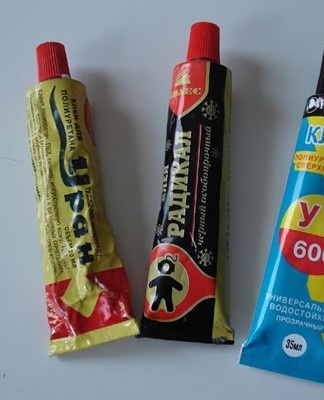
Work should be done with gloves to protect the skin from exposure to acetone. It is most convenient to work with the composition with flute brushes, the size of which depends on the size of the treated area. At the end of gluing, the tool is washed with acetone and dried. Hands are thoroughly washed with soap.
Store containers with underused glue in a tightly closed container at a temperature of +10 to +25 degrees in a room where children and animals do not have access. During storage, proximity to an open flame, heaters, direct sunlight are not allowed, as polyurethane rubbers are flammable.
Crystallization of the composition, if the shelf life is not exceeded, does not affect the adhesive properties. The container with glue is placed in a water bath at a temperature of up to 70 degrees. After 10-60 minutes (depending on the amount of the composition), the glue is mixed with a wooden/glass stick until smooth.
"UR-600" surpasses other adhesives in the quality of the joint for PVC and rubber products. The peculiarity of the composition allows them to create monolithic connections, which are successfully used in the repair of boats, boots, bags. This is because polyurethane rubbers are part of rubber and polyvinyl chloride.The presence of acetone in the glue softens the structure of the original products and promotes the adhesion of homogeneous substances.


